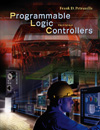|
 |  Programmable Logic Controllers, 3/e Frank Petruzella
Book PrefaceProgrammable logic controllers (PLCs) are used in every aspect of industry to expand and enhance production. Where older automated systems would use hundreds or thousands of relays, a single PLC can be programmed as a replacement. The functionality of the PLC has evolved over the years to include capabilities beyond typical relay control: sophisticated motion control, process control, distributive control systems, and complex networking have now been added to the PLC's list of functions.
This third edition of Programmable Logic Controllers provides an up-to-date introduction to all aspects of PLCs from their operation to their vast range of applications. It focuses on the underlying principles of how PLCs work and provides practical information about installing, programming, and maintaining a PLC system. No previous knowledge of PLC systems or programming is assumed.
The primary source of information for a particular PLC model is always the user's manual, which is published by the manufacturer. This textbook is not intended to replace that user’s manual but rather to complement, clarify, and expand on the information found within it. With the number of companies currently offering PLCs, it is not practical to cover the specifics of the different makes and models in a single text. With this in mind, the text discusses PLCs in a generic sense. Although the content is of a nature to allow the information to be applied to a variety of PLC models, this book uses the popular Allen-Bradley PLC-5, SLC-500, and ControlLogix controller instruction sets for the programming examples.
The text is written in an easy-to-read and understandable language, with many clear illustrations to assist the student in comprehending the fundamentals of a PLC system. Objectives are listed at the beginning of each chapter to inform students what they should learn. The subject material follows this list. The relay equivalent of the programmed instruction is explained first, followed by the appropriate PLC instruction. Each chapter concludes with a set of review questions and problems. The review questions are closely related to the chapter objectives and will help students evaluate their understanding of the chapter. The problems range from easy to difficult, thus challenging students at various levels of competence.
All topics are covered in small segments so students can develop a firm foundation for each concept and operation before they advance to the next. An entire chapter is devoted to logic circuits as they apply to PLCs. PLC safety procedures and considerations are stressed throughout the text. Technical terms are defined when they are first used, and an extensive glossary provides easy referral to PLC terms. General troubleshooting procedures and techniques are stressed, and students are instructed in how to analyze PLC problems systematically.
This edition has been revised to include a number of new features:
- RSLogix Windows-based programming is covered in detail.
- The ControlLogix instruction set has been added.
- All chapters have been expanded to include recent developments.
- Equipment illustrations have been updated.
- The glossary has been expanded.
Both a student activities manual and a computer simulation package may be purchased for use with Programmable Logic Controllers, third edition. The accompanying Activities Manual contains chapter tests consisting of true/false, completion, matching, and multiple-choice questions related to the theory covered in the text. The best way to fully understand the operation of a given PLC system is by hands-on experimentation with the equipment. With this in mind, the Activities Manual also contains a wide range of generic programming assignments and exercises designed to offer students real-world experience with their PLC installation.
The accompanying Computer Simulation Package includes state-of-the-art LogixPro simulation software as well as a printed lab manual with more than 250 programming assignments. The LogixPro simulation software converts the student’s computer into a PLC and allows the student to write ladder logic programs and verify their real-world operation. LogixPro is an ideal tool to help students learn the fundamentals of Allen Bradley's RSLogix ladder logic software. The programming assignments provide students with the opportunity to familiarize themselves with many different features associated with PLCs, including timers, counters, sequencers, and math functions.
Acknowledgement
I would like to thank the following reviewers for their comments and suggestions.
Christine L. Berger-Wilkey, Lake Area Technical Institute (Watertown, SD)
Thomas E. Clark, National Institute of Technology (Long Beach, CA)
David C. Kier, Florida Community College at Jacksonville
John Lenahan, Southeastern Community College (W. Burlington, IA)
William Salice, Computer Electronics Technology
David A. Setser, Johnson County Community College
Dan Siddall, SCP Global Technologies
In addition, I would like to thank everyone who responded to the survey that was sent out during the preparation of this edition. Finally, I would like to thank the team at McGraw-Hill Higher Education -- namely, David Culverwell, Pat Forrest, Jane Mohr, Karen Dorman, and David Tietz -- for their much-appreciated assistance with the publication process. |
|
|




 2005 McGraw-Hill Higher Education
2005 McGraw-Hill Higher Education


 2005 McGraw-Hill Higher Education
2005 McGraw-Hill Higher Education